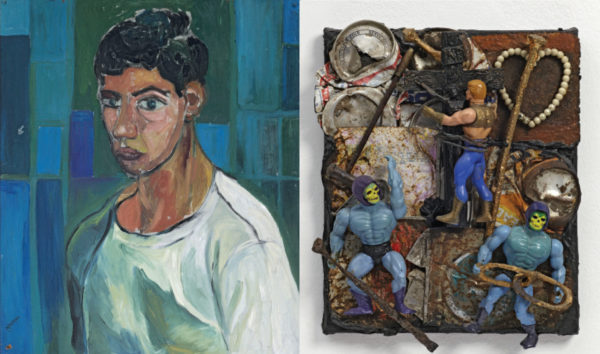
By David Prendeville
Running from now until February 23rd at the Irish Museum of Modern Art is PROTEST! – a major retrospective of the work of one of the most influential figures in 20th century British culture, Derek Jarman.
While addressing Jarman’s important contribution to film, this exhibition focuses on his wider practice as a painter, writer, set-designer, gardener and political activist. This is the first time that these diverse strands of his practice have been brought together in over 20 years.
PROTEST! captures Jarman’s engagement with both art and society, as well as his contemporary concerns with political protest and personal freedoms arising from the AIDS crisis. Major bodies of work, from the 1960s to the 1990s, have been brought together, many of which have never been seen in public before.
Derek Jarman studied at the Slade School of Art, London in the early 1960s, and was part of a group of young painters, including Patrick Procter and David Hockney, who embodied a changing mood in British art.
More than 80 early works have been identified from the period 1958 to 1970, and some 30 of these are previously unknown and have been catalogued, conserved and documented for this exhibition.
In 1967 Jarman was included in Tate Young Contemporaries; in the inaugural exhibition at the Lisson Gallery and the 5th Biennale des Jeunes, Paris; a remarkable record of achievement for a painter in his mid-twenties. Alongside painting he began to produce set designs for opera and ballet, which fused his personal style of painting with the scale and three-dimensionality needed for the theatre.
Sometimes called ‘The Andy Warhol of London’, as early as 1967 Jarman was hired to create production design sets such as Jazz Calendar by Frederick Ashton at the Royal Ballet; and in 1971 the sumptuous set for Ken Russell’s brilliant and controversial The Devils.
The exhibition includes many original designs by Jarman; photographs of the realised sets and a group of seven costumes designed by Oscar-winning costume designer Sandy Powell.
While collaboration was at the heart of Jarman’s practice, it also highlights his status as an incubator of young talent. Figures such as Tilda Swinton, Toyah Wilcox, Joanna Hogg, Sean Bean and John Maybury had their first opportunities under Jarman’s direction.
Throughout his career Jarman retained a deep interest in history and the art of the past. In 1976 he produced his first full-length feature film Sebastiane, a queer telling of the story of the martyrdom of St Sebastian, featuring a haunting score by Brian Eno.
Against the backdrop of Thatcherism and a socially conservative Britain, Jarman’s work made queer lives and history visible; a provocation to the dominant hierarchies. His films Sebastiane (1976) and Jubilee (1978) were broadcast on Channel 4 in the early 80s to a very broad audience. This led to a conservative backlash from figures such as Mary Whitehouse and Conservative MP Winston Spencer-Churchill, grandson of the wartime prime minister, who appealed to the Arts Minister to have funding withdrawn.
Jarman responded by becoming ever-more frank and un-apologetic about his subject matter, and from the late 80s, put queer lives at the centre of his practice through figures such as Caravaggio, Edward II and Wittgenstein.
Caravaggio’s life and art were a source of inspiration for their fusion of passion, beauty and violence. Over a period of more than ten years Jarman made paintings using techniques borrowed from the Renaissance master. Making a feature film on Caravaggio’s life became an obsession. This research led to the creation of volumes of sketchbooks, storyboards, and paintings, included in this retrospective.
Following the release of the film Caravaggio in 1986, he received recognition by the Tate Gallery when he was included as a nominee for the Turner Prize that year.
At the end of 1986 Jarman was diagnosed as HIV-positive. AIDS was then a fatal, non-treatable disease which the tabloid press described as a plague.
This diagnosis transformed Jarman’s practice and led to a new kind of activism as he worked to raise awareness of AIDS. He was one of the few public figures to ‘come out’ with the disease, an extraordinary act of courage in the social and political climate of the time.
This is expressed in his paintings such as Queer (1992) (Manchester Art Gallery Collection), from his expansive series of ‘Slogan Paintings’. These monumental works, from the early 1990s, incorporating phrases related to government policy, tabloid hysteria and public fear of the AIDS crisis, are included in the exhibition and remain powerful comments on the socio-political climate of the time.
Jarman’s diagnosis coincided with a move to Prospect Cottage in Dungeness, Kent, which is overshadowed by the Dungeness nuclear power station. Here he created a unique and highly-regarded garden, the site of his film The Garden (1990) and book Derek Jarman’s Garden (1995).
For this exhibition the garden will be the subject of new critical texts which will explore its lasting legacy and its place as a living work of art. The diverse bodies of works that were made there, tar paintings, landscape paintings, assemblages and feature film are represented in the exhibition.
Moving image works from across Jarman’s career are also shown throughout the exhibition, charting the evolution of his filmmaking. Jarman remains an essential and influential figure in contemporary art. Against the AIDS crisis and the backdrop of Section 28, enacted on the 24 May 1988 that stated that a local authority “shall not intentionally promote homosexuality or publish material with the intention of promoting homosexuality,” Jarman made explicitly political art.
In his use of installations (including beds), multiple media and religious iconography he prefigured the work of younger artists, including Tracey Emin and Damien Hirst.
This is a powerful, exhaustive, diverse and often provocative body of work. There’s plenty on show to please a wide array of tastes. The haunting contemplations on death seen in his film Blue, to the mischief of his ‘Black Paintings’, to the anger of his Slogan paintings.
My favourite room in the exhibition was the Prospect Cottage room. Particulalry striking in here were objects which combine religious icons purchased in gift shops with the paraphenilia of war and sex, to haunting effect.
This is an unforgettable and unmissable exhibition. It runs until February 23rd and entry is free of charge.



